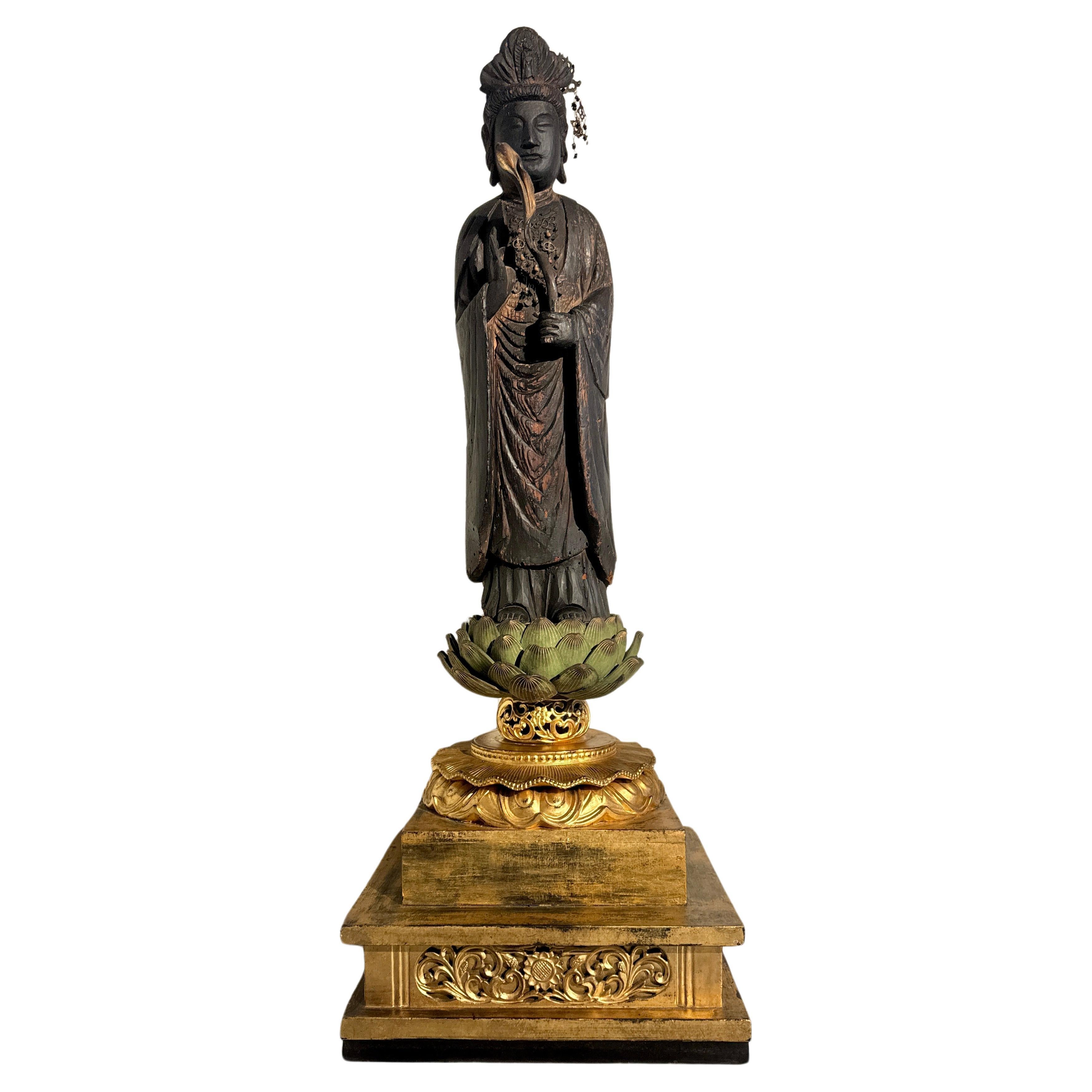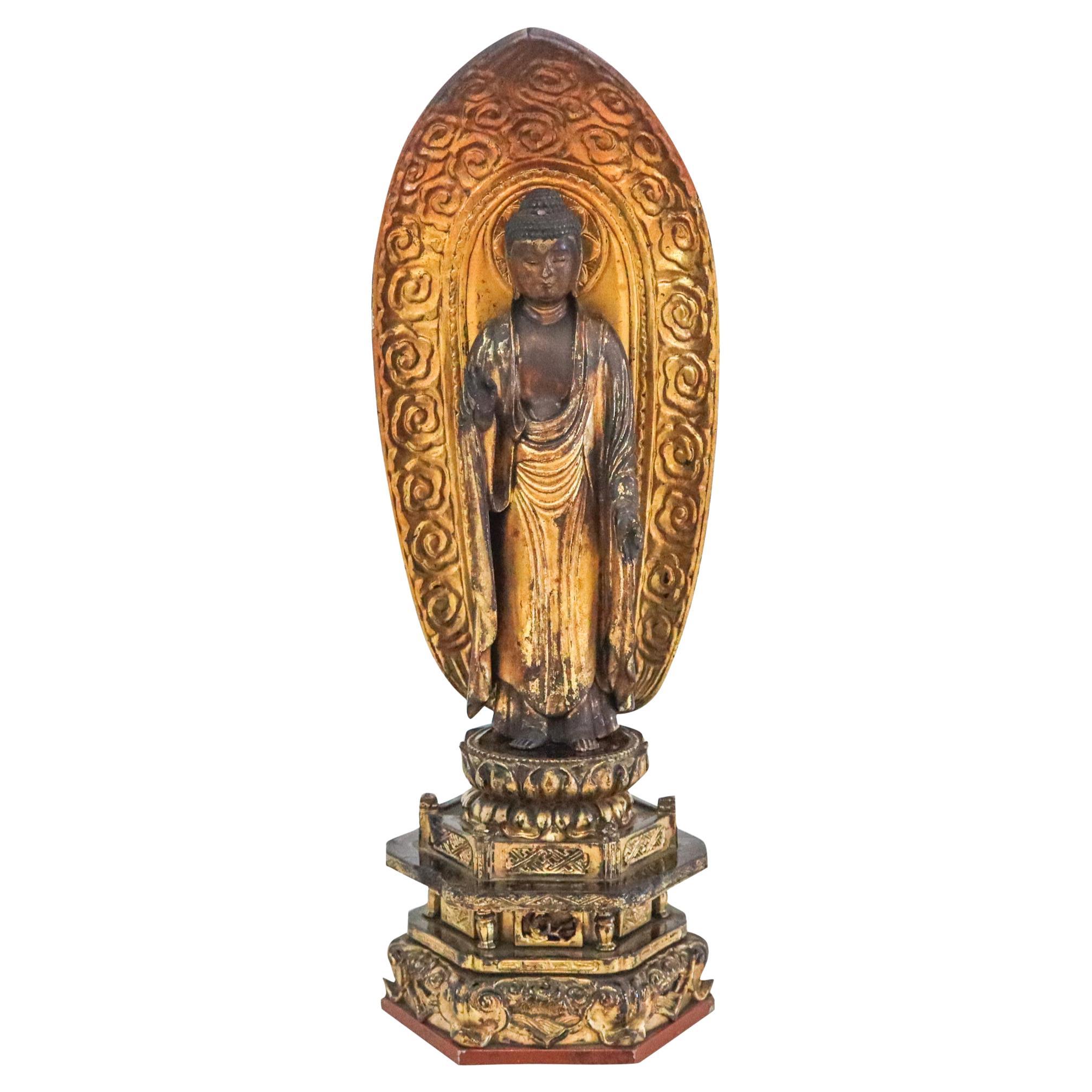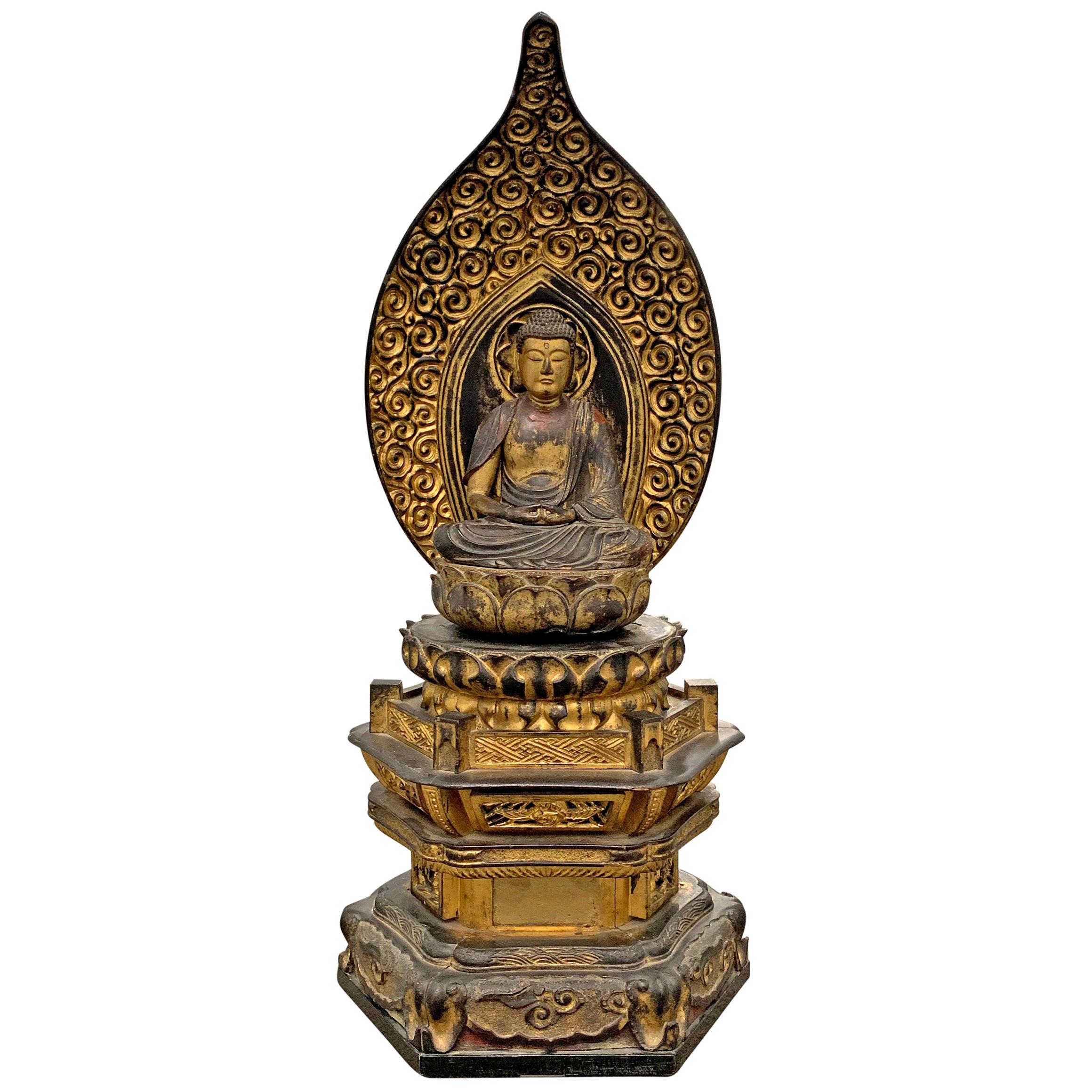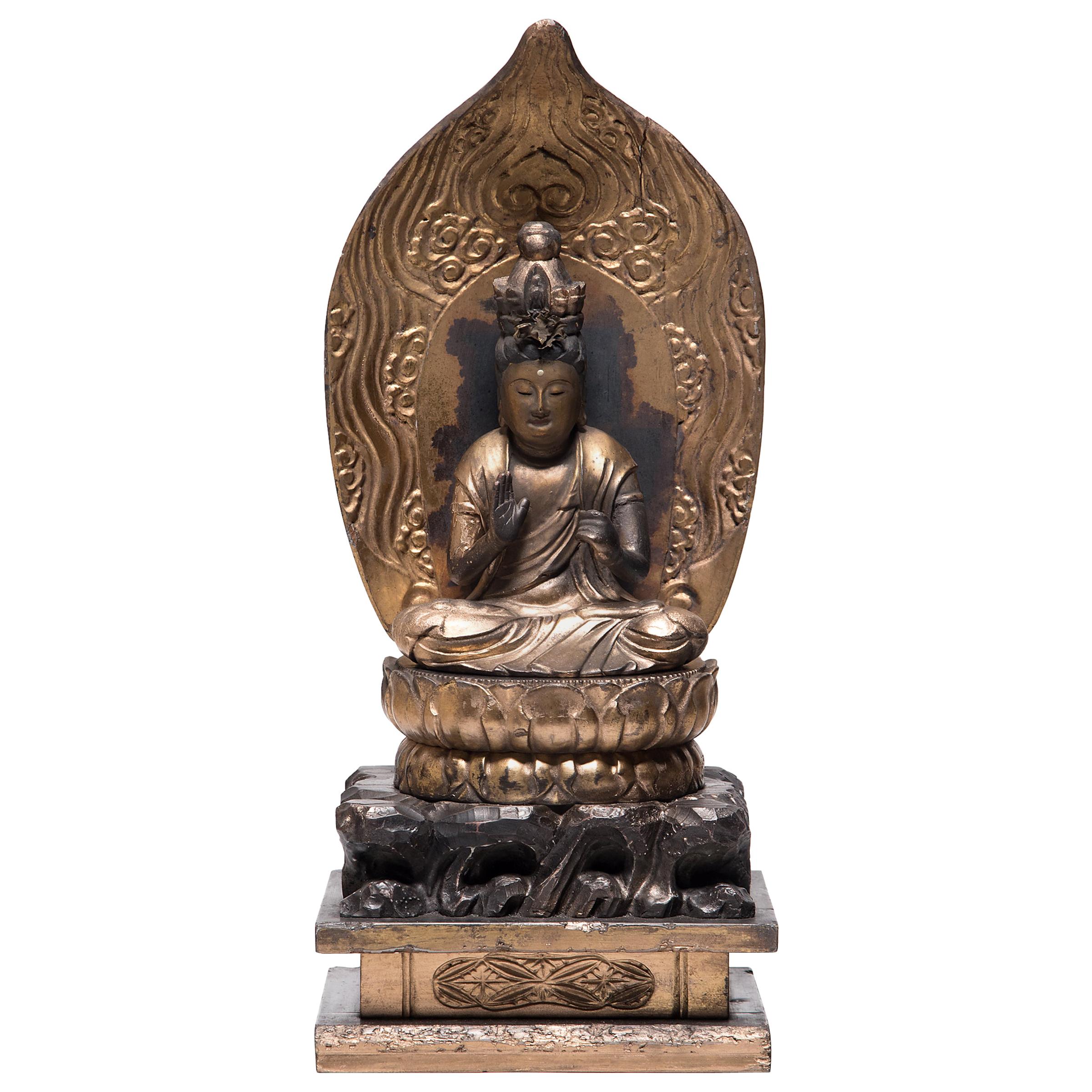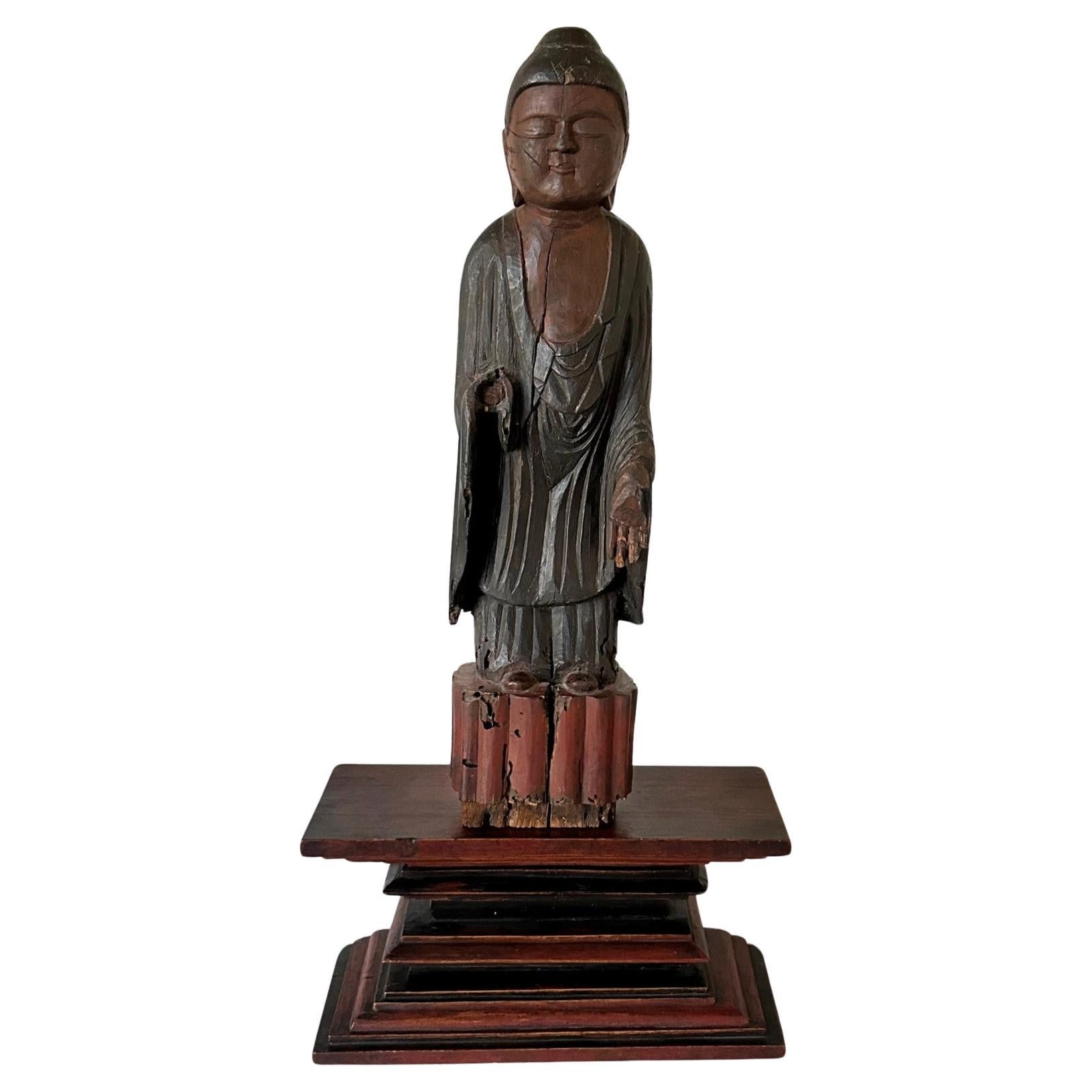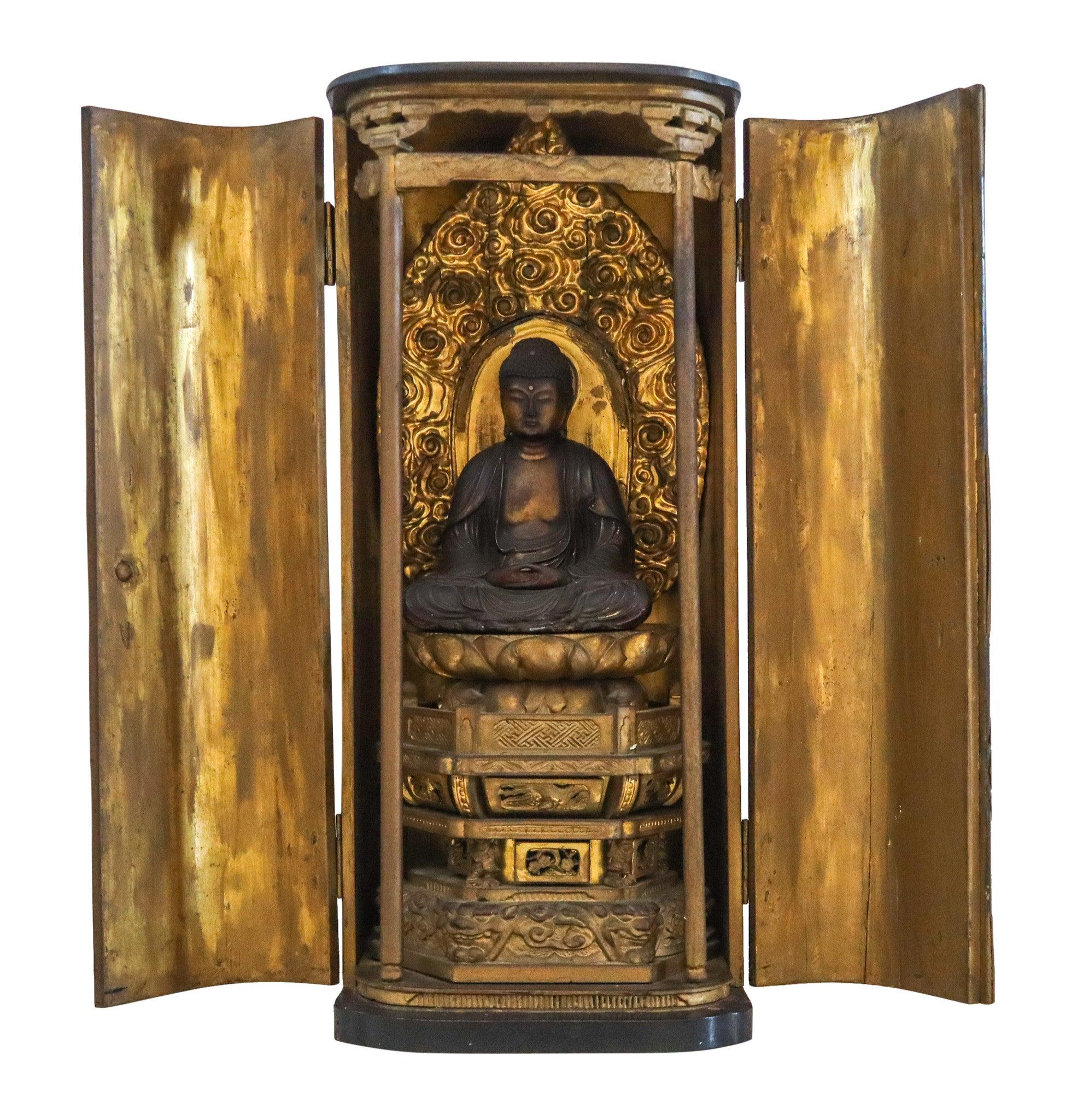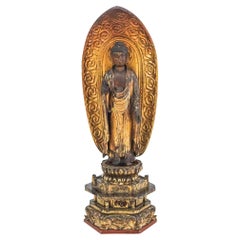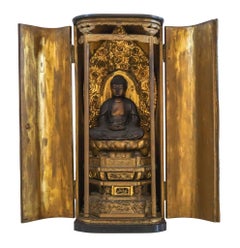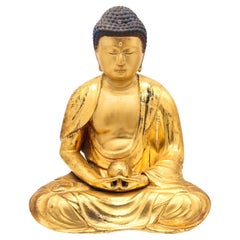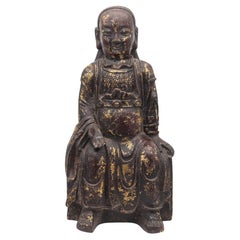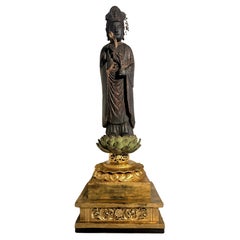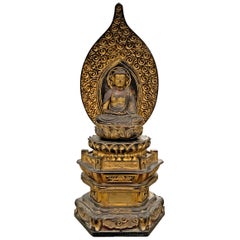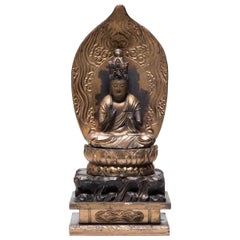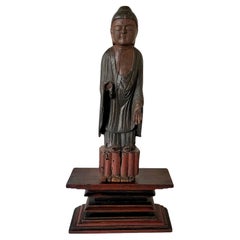Items Similar to JAPAN 1810 Edo Period Large Butsudan Home Altar With Amida Nyorai In Wood
Want more images or videos?
Request additional images or videos from the seller
1 of 8
JAPAN 1810 Edo Period Large Butsudan Home Altar With Amida Nyorai In Wood
$4,985
£3,782.50
€4,324.95
CA$6,962.69
A$7,741.57
CHF 4,042.22
MX$94,233.73
NOK 51,576.96
SEK 48,325.15
DKK 32,277.93
Shipping
Retrieving quote...The 1stDibs Promise:
Authenticity Guarantee,
Money-Back Guarantee,
24-Hour Cancellation
About the Item
Large butsudan home altar with Amida Nyorai figure Edo Period (1600-1868)
This is a beautiful Japanese wooden statue of standing Amida Nyorai Buddha, from the Edo period (1600-1868). The enlightened founder of Buddhism, exudes serenity and profound spiritual presence. The finely hand-carved figure stand in deep meditation, radiating a sense of timeless wisdom. Encased within an elegant Buddhist altar cabinet, this piece embodies the artistry and devotion of generations past.
The statue’s altar is a masterpiece in itself, featuring layered, intricate carvings of traditional motifs, reflecting exceptional craftsmanship. The interior of the cabinet is coated in lacquer mixed with gold powder, traces of which remain on the Buddha figure, though the front has been worn smooth with time. The base and halo retain much of their original finish, harmonizing with the overall composition. The exterior is finished in deep black lacquer, punctuated by aged brass fittings that add to its noble presence.
Signs of age and historical use add character to this sacred work of art. The Buddha figure shows surface wear, discoloration, and remnants of the original lacquer. The halo exhibits surface deterioration, with some lacquer cracks and chipping. The bottom of the statue has an old repair where a break was reattached. The cabinet bears scuffs, scratches, and lacquer cracks, while the brass fittings display a rich patina developed over time. Please refer to the photos for further details on the condition.
The Edo Period
The Edo period or Tokugawa period is the period between 1603 and 1867 in the history of Japan, when Japan was under the rule of the Tokugawa shogunate and the country's 300 regional daimyo. Emerging from the chaos of the Sengoku period, the Edo period was characterized by economic growth, strict social order, isolationist foreign policies, a stable population, perpetual peace, and popular enjoyment of arts and culture. The period derives its name from Edo (now Tokyo), where on March 24, 1603, the shogunate was officially established by Tokugawa Ieyasu. The period came to an end with the Meiji Restoration and the Boshin War, which restored imperial rule to Japan. The Tokugawa (or Edo) period brought 250 years of stability to Japan. The political system evolved into what historians call bakuhan, a combination of the terms bakufu and han (domains) to describe the government and society of the period. In the bakuhan, the shōgun had national authority and the daimyo had regional authority. This represented a new unity in the feudal structure, which featured an increasingly large bureaucracy to administer the mixture of centralized and decentralized authorities. The Tokugawa became more powerful during their first century of rule: land redistribution gave them nearly seven million koku, control of the most important cities, and a land assessment system reaping great revenues.
Country: Japan.
Period: Edo Period, Circa 1810.
Materials: Wood, gold, lacquer and bronze.
Weight: About 3.5 Pounds (1.59 Kg.).
Measurements: 625 mm by 266 mm by 217 mm (24.60 x 10.47 x 8.55 Inches).
Collateral: This Amida Nyorai devotive piece is accompanied by a certificate of authenticity stating the description, the period of manufacture and the components.
Condition: Good condition considering its age, there are signs of wear from age and normal use, chips, marks, scratches, dirt, rubbing, peeling; for actual condition, please, take a look at pictures.
INVENTORY REF: D031425XOEN/.6510
- Dimensions:Height: 24.6 in (62.49 cm)Width: 10.47 in (26.6 cm)Depth: 8.55 in (21.72 cm)
- Style:Edo (Of the Period)
- Materials and Techniques:
- Place of Origin:
- Period:
- Date of Manufacture:1810
- Condition:Wear consistent with age and use. Good condition considering its age, there are signs of wear from age and normal use, chips, marks, scratches, dirt, rubbing, peeling; for actual condition, please, take a look at pictures.
- Seller Location:Miami, FL
- Reference Number:Seller: D031425XOEN/.65101stDibs: LU8303244641172
About the Seller
5.0
Gold Seller
Premium sellers maintaining a 4.3+ rating and 24-hour response times
1stDibs seller since 2023
206 sales on 1stDibs
Typical response time: 4 hours
- ShippingRetrieving quote...Shipping from: Miami, FL
- Return Policy
Authenticity Guarantee
In the unlikely event there’s an issue with an item’s authenticity, contact us within 1 year for a full refund. DetailsMoney-Back Guarantee
If your item is not as described, is damaged in transit, or does not arrive, contact us within 7 days for a full refund. Details24-Hour Cancellation
You have a 24-hour grace period in which to reconsider your purchase, with no questions asked.Vetted Professional Sellers
Our world-class sellers must adhere to strict standards for service and quality, maintaining the integrity of our listings.Price-Match Guarantee
If you find that a seller listed the same item for a lower price elsewhere, we’ll match it.Trusted Global Delivery
Our best-in-class carrier network provides specialized shipping options worldwide, including custom delivery.More From This Seller
View AllJAPAN Edo Period 1750 Amida Nyorai Buddha Sculpture In Gilt Carved Wood
Located in Miami, FL
An Amida Nyorai Sculpture In Gilt Carved Wood from the Edo Period.
This is a superbly refined carved wooden figure of Amida Nyorai (Amitabha), the Buddha of Infinite Light, with fab...
Category
Antique 1750s Japanese Edo Sculptures and Carvings
Materials
Gold, Bronze, Gold Leaf
JAPAN 1800 Edo Period Seated Shakyamuni Buddha In Zushi Buddhist Altar Cabinet
Located in Miami, FL
Seated Shakyamuni Buddha in a Lacquered Zushi Buddhist Altar Cabinet.
This is a remarkable Japanese wooden statue of Shakyamuni Buddha 釈迦如来坐像, from the Edo period (1600-1868). The...
Category
Antique Early 1800s Japanese Edo Sculptures and Carvings
Materials
Gold, Berlin Iron
JAPAN Edo Period 1825 Seated Buddha Sculpture In Solid Gilded Carved Wood
Located in Miami, FL
A seated Buddha sculpture in gilt carved wood from the Edo Period.
This is a superbly refined carved wooden figure of a seated Buddha with fabulous pure gold gilt. The sculpture has...
Category
Antique 1820s Japanese Edo Sculptures and Carvings
Materials
Gold
QING DYNASTY 1850 Sculptural Enthroned Mazu Quan-Yin In Solid Gilded Bronze
Located in Miami, FL
A 19th century enthroned Mazu Quan Ying from the Qing Dynasty.
This is a beautiful antique sculptural figure of an enthroned Mazu Quan Yin, cast in bronze in high relief in the late...
Category
Antique 1850s Chinese Qing Metalwork
Materials
Bronze, Gold
QING DYNASTY 1880 Seated Enthroned Mazu Quan-Yin In Solid Gilt Bronze
Located in Miami, FL
A 19th century enthroned Mazu Quan Ying from the Qing Dynasty.
This is a beautiful antique sculptural figure of an enthroned Mazu Quan Yin, cast in bronze in high relief in the late...
Category
Antique 1880s Chinese Qing Metalwork
Materials
Bronze, Gold
Japan 1800 Edo Period Six Drawer Inro In Lacquered Gilt Wood With Utensils
Located in Miami, FL
Japanese Inro from the Edo Period (1603-1867).
Beautiful Inro, created in Japan during the Edo period (Shogunate), circa 1800. It was carefully crafted in carved precious wood with ...
Category
Antique Early 1800s Japanese Edo Lacquer
Materials
Coral
$2,600 Sale Price
20% Off
You May Also Like
Japanese Lacquered Wood Sho Kannon, Momoyama/Edo Period, 17th Century, Japan
Located in Austin, TX
A tall and impressive Japanese carved and black lacquered figure of Sho Kannon Bosatsu, Momoyama or Edo Period, mid 17th century, on a later mid 19th century carved, painted, and gilt wood lotus...
Category
Antique Mid-17th Century Japanese Edo Sculptures and Carvings
Materials
Metal
Edo Period Japanese Bodhisattva Shrine
Located in Chicago, IL
An incredible Edo Period Japanese gilt and lacquered carved wood shrine depicting a Bodhisattva with piercing glass eyes, a contemplative expression, and h...
Category
Antique Early 1800s Japanese Japonisme Sculptures and Carvings
Materials
Giltwood, Lacquer, Wood
$13,125 Sale Price
25% Off
Japanese Gilt Seated Kannon Figure, circa 1850
Located in Chicago, IL
Intricately carved and finished with gilt black lacquer, this seated figure depicts the bodhisattva Guanyin, known in Japanese Buddhism as Kannon. Described as the "Buddha of Infinite Compassion," Kannon is the embodiment of mercy and makes himself available to all who call upon him with all their mind.
Kannon is depicted here seated in diamond position upon a double lotus plinth, set above a stepped base. He is dressed in gracefully draped robes and wears a tall crown bearing a minuscule figure of Amida, the Buddha of Infinite Light. He has a serene expression of calm and holds his right hand in the abhaya mudra, a gesture of comfort, blessing, and protection. Backed by a magnificent leaf-form nimbus, this Kannon figure...
Category
Antique Mid-19th Century Japanese Edo Sculptures and Carvings
Materials
Wood, Lacquer
Antique Japanese Carved Village Buddha Enku Style
Located in Atlanta, GA
A carved wood buddha with lacquered surface in the style of Erku (1632–1695), a monk from Edo period who was famous for hand-carving Buddha statues in a primitive style. From a single wood block of what appears to be cedar, the standing buddha was carved in an unpolished manner with exposed knife strokes that effectively depicted a subtly smiling face and the folding of the cascading robes. The rustic style is full of Mingei charm being a great example of Japanese Buddhism...
Category
Antique 18th Century Japanese Edo Sculptures and Carvings
Materials
Wood
Japanese antique wooden Buddha statue / Edo period / 1600 to 1800
Located in Sammu-shi, Chiba
This wooden statue is a relic from Japan's Edo period, and within it lies a deep history that transcends time. Originally, it was part of a more intricate statue, likely adorned with...
Category
Antique 17th Century Japanese Edo Sculptures and Carvings
Materials
Cypress
Japanese Giltwood Medicine Buddha, Yakushi Nyorai, Muromachi Period 16th Century
Located in Austin, TX
A striking Japanese late Muromachi Period (1333-1573) lacquered and giltwood figure of Yakushi Nyorai, the Medicine Buddha, seated upon an elaborate car...
Category
Antique 16th Century Japanese Edo Sculptures and Carvings
Materials
Rock Crystal
